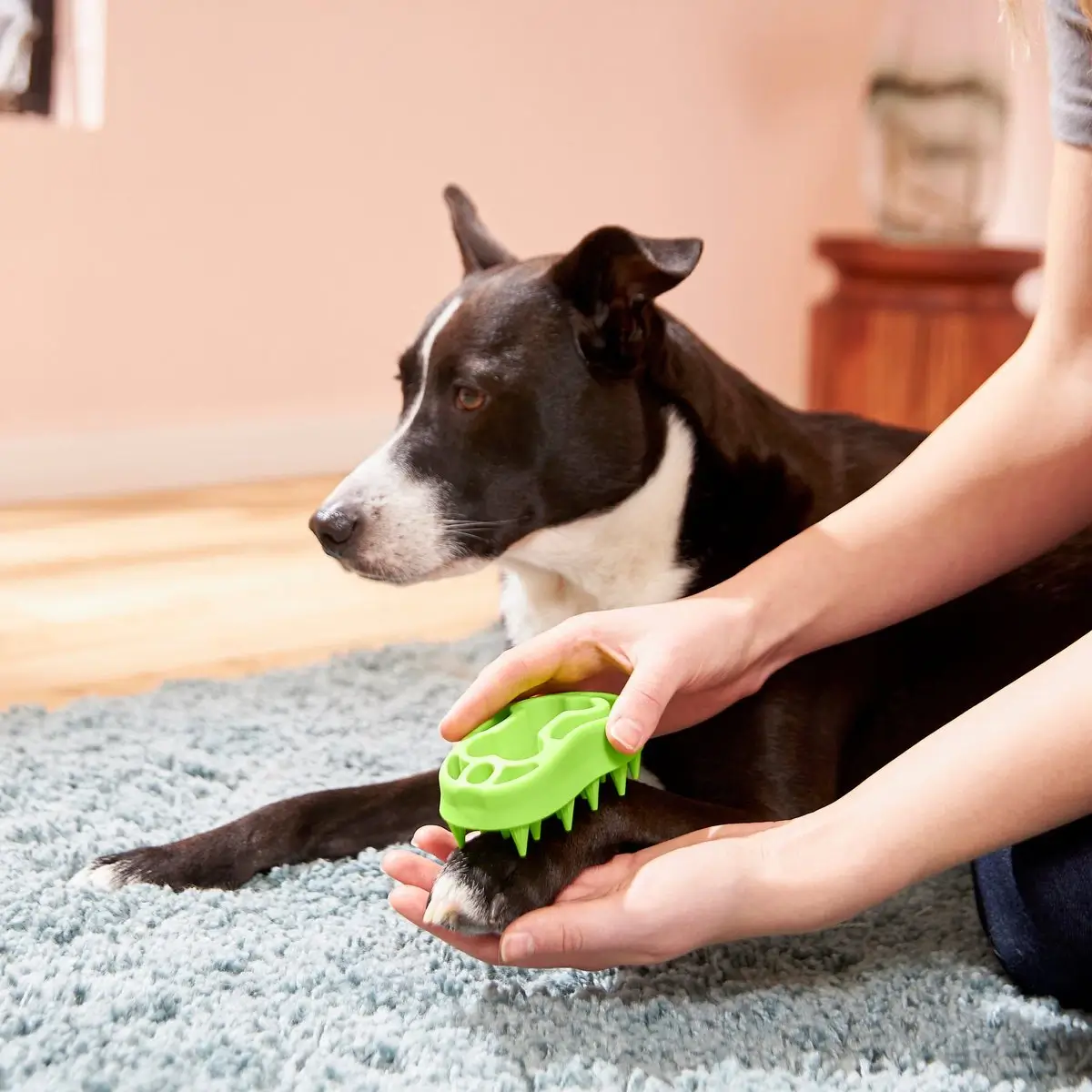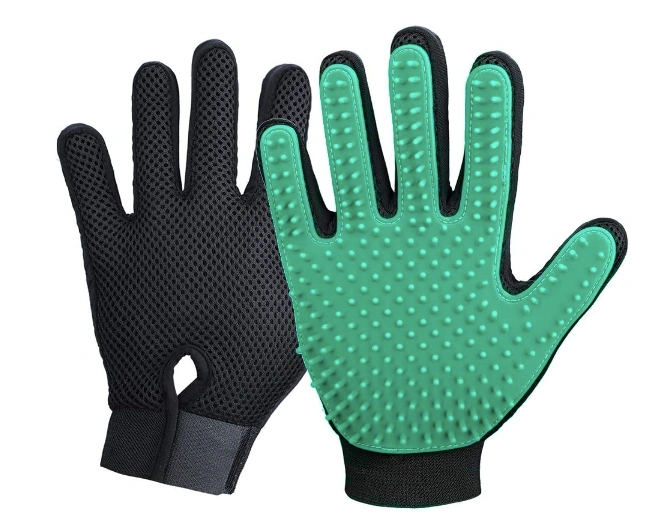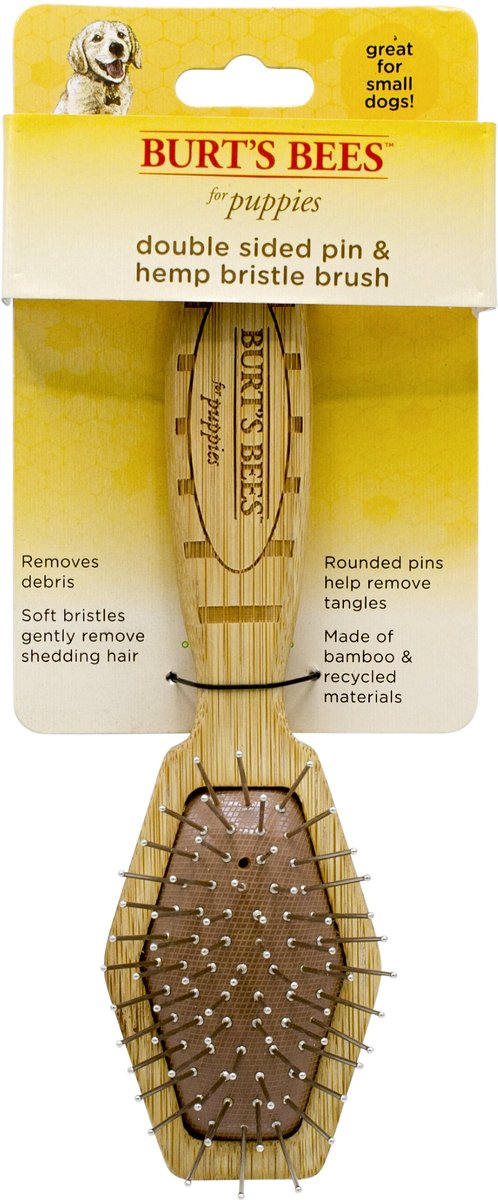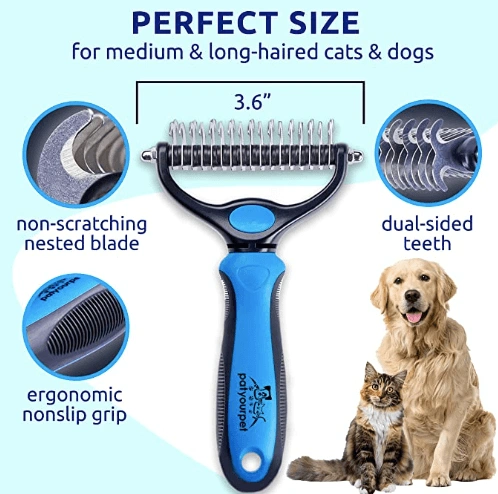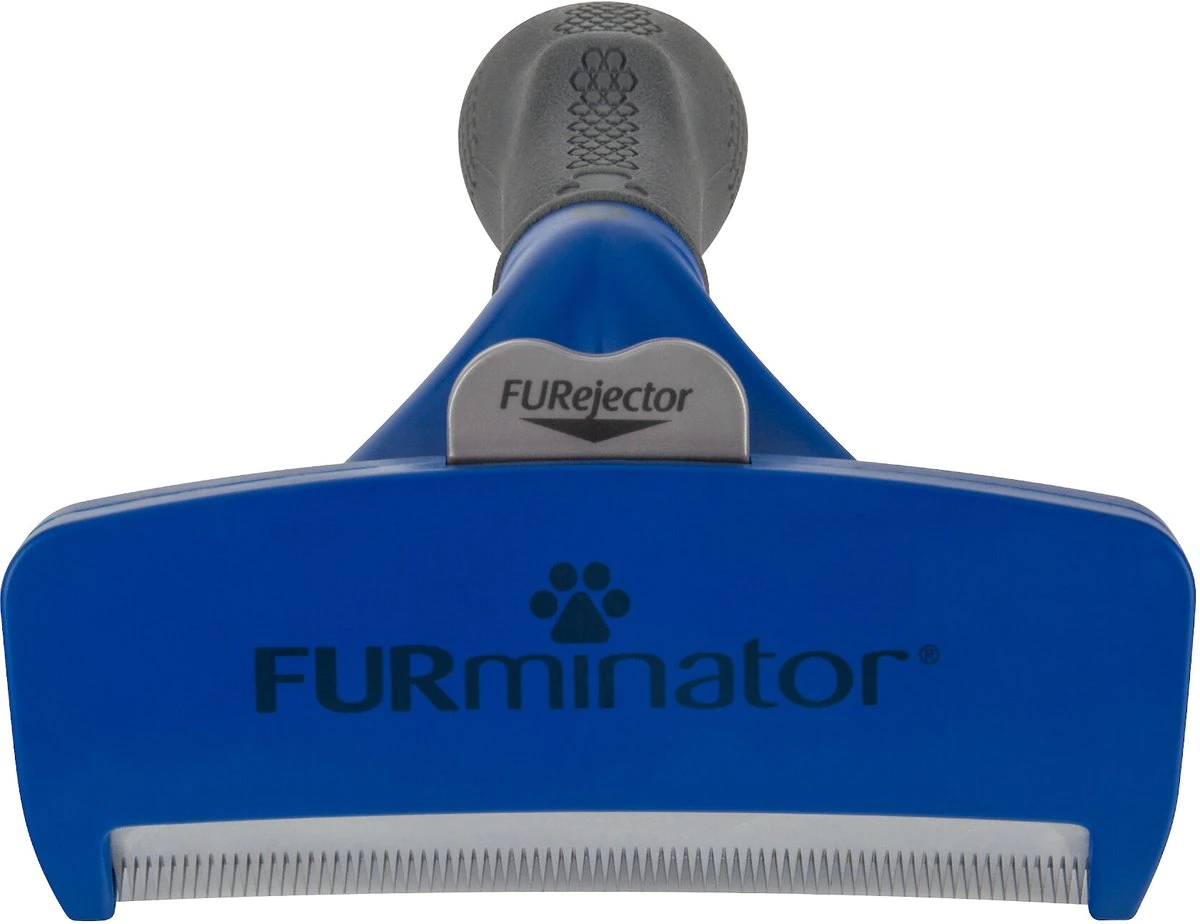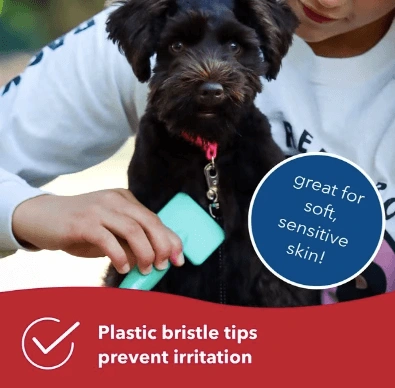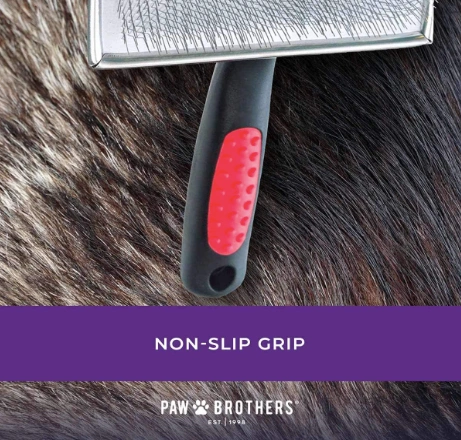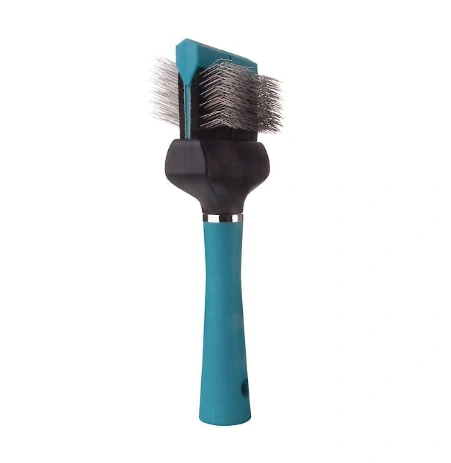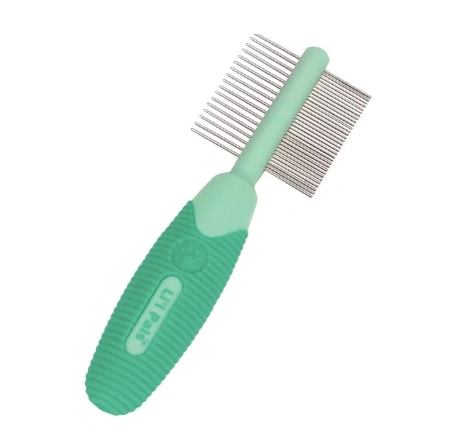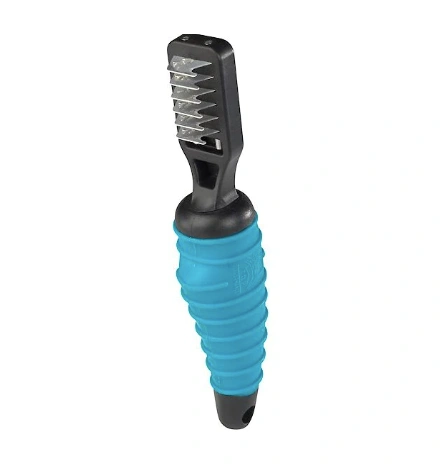As conscientious puppy pawrents, we want to do what we can to raise a happy and healthy puppy, and part of that is helping your pooch look and feel his or her best. Brushing your dog is an easy way to make your dog feel loved and well cared for.
You don’t have to go to a professional groomer to brush your dog. As busy as we can get, taking the time every few days (or daily for some breeds) to brush our dogs will help us get into a routine.
As we emerge from the pandemic, you may have opted to groom your dog at home. You can also save a lot of money if you learn dog grooming techniques yourself! Even if you do go to a professional grooming salon, you’ll need to manage your dog’s coat to prevent all sorts of problems.
But how do you know which dog brush is right for your breed’s haircoat? Find out why dogs must be brushed regularly and how to select the right dog brush for your puppy’s coat with our 15 dog brush recommendations.
Health Benefits of Brushing Your Dog
A good brushing session offers so many benefits for your pooch! Brushing your dog on a regular basis not only keeps your pooch looking good – it can also have health benefits. See how brushing your dog is important in the following ways:
- Promotes blood circulation
- Prevents your dog from stinking
- Clears the coat of dead and dry skin
- Keeps your dog looking good and well-kept
- Detects parasites, skin infections, and hot spots
- Removes loose and dead hairs, clearing the way for new growth
- Helps redistribute a dog’s natural coat oils for a healthy, glossy coat
- Removes mats and tangles that can weigh down your dog’s skeleton
- Increases your bond with your dog since you’re giving devoted attention to your pooch
- Allows you to know your dog’s natural body shape in case you discover abnormal lumps or bumps
- Combats shedding by staying on top of loose hairs (preventing those tumbleweeds of hair that accumulate quickly)
How to Brush Your Dog
It might be silly to mention how to brush your dog because you may be thinking, “Well that’s not difficult! I just grab a brush and have a go at it, right?” Well, there’s a bit more to it than starting in without thinking about what you’re doing.
Much like on a human’s head, you wouldn’t start in a random place like the base of the scalp going up or yank through tangles. Regardless of breed, brushing your dog in a methodical, thoughtful manner will help you get the best results.
You should start introducing grooming tools to your puppy as early as possible to get them familiar with the motions and equipment. If you get your dog when he or she is a bit older, make it a positive experience by keeping brushing time short, frequent, and ending in lots of delicious puppy treats and positive praise. That way, they will associate brushing as a happy event rather than trying to bite the brush!
Check to see if your dog’s coat is dry. Start at the feet (not the head like you might think) and brush gently and steadily in the direction of hair growth, working your way up the body to the shoulders. Avoid going against the direction of hair growth, as that can hurt your dog. Next, do the face and ears, and lastly, their back.
Be sure to empty the brush every now and then because it will be clogged with dog hair in no time! Consider leaving the clumps of hair outside for birds to build their nests, especially in the springtime.
Choose the Right Dog Brush For Your Breed
The beauty of dogs is that they come in all shapes and sizes. There are so many combinations of coat types in the canine world! A dog’s coat can vary in color, pattern, length, texture, and number of layers. It’s important to choose the right type of dog brush to cater to your dog’s specific coat because each type calls for a specialized brush in order to properly remove fur and keep your dog looking great.
Single coat vs. double coat
Dogs typically have one of two coat types: a single-layer or a double-layer dog coat. They each have advantages and disadvantages either way you look at it, but they’ll need the right tool for the job.
Brushes for single-coated dogs
A dog with a single coat has one layer of dense hair that can be any length. This single layer of hair growth is typically easier to groom because you only deal with one layer.
Some people may think that if a dog has a single-layer coat, it won’t shed as much. While it can absolutely be true since there aren’t 2 layers to contend with shedding, don’t count on it being the standard. Short-haired dogs with a single layer of hair growth can still shed quite a bit!
A dog with a single coat will not be able to withstand bigger temperature differences like a double-coated dog, so it’s important to keep them out of extreme heat or cold and buy some cute & warm sweaters for them during colder months.
Single-haired, sleek-coated dogs are some of the easiest dog breeds to brush because they don’t have much to work with! Using brushes with rubble bristles helps gently redistribute oils and keep their skin and coat clean.
Bone Dog Curry Brush by Frisco
Pet Hair Remover Gloves with 255 Tips
Puppy Double-Sided Pin and Bristle Brush by Burt’s Bees
- Pugs
- Boxers
- Boston Terriers
- French Bulldogs
- English Bulldogs
- Italian Greyhounds
- Cane Corso Mastiffs
- American Pit Bull Terriers
Brushes for double-coated dogs
A double-coated dog has two layers of hair: an outer coat layer that is often weather-proof consisting of sturdy, coarse, long guard hairs, and an undercoat consisting of fine, downy, soft fur that acts as an insulator.
It’s extremely important to brush a double-coated dog frequently to remove both layers of loose fur! Most double-coated dogs will shed year-round, especially when they “blow” their coat twice a year to change for the upcoming seasons.
Double-coated dogs will have more ability to regulate their own temperature, whether in the cold or the heat, due to how the layers work together in circulating air near the skin. For that reason, a double-coated dog should never be shaved, even when you think it might be cooler. That’s not the case!
One type of dog brush is probably not just enough. You’ll need a few tools to remove the undercoat using a brush with teeth that are closer together to de-fur your puppy and then one with wider, sturdy teeth to remove the overcoat. An undercoat rake (or comb) can remove the underlayer, while a de-furring brush will help when they blow their coats.
Deshedding Brush - Double-Sided Undercoat Rake for Dogs & Cats by Pat your Pet
https://www.amazon.com/dp/B01EZ7UOCM?th=1
Long Hair Dog Deshedding Tool by FURMINATOR
Dual-Sided Shedding Blade Dog Grooming Tool by Safari
- Akitas
- St. Bernards
- Chow Chows
- Great Bernese
- Siberian Huskies
- Golden Retrievers
- German Shepherds
- Bernese Mountain Dogs
Straight, medium hair
You may opt to trim your long or medium-haired dog into a shorter coat, but if you don’t, a slicker brush is a tool with sometimes flexible wire bristles, often coated in plastic at the end for comfort that is a great all-around tool. A pin brush features stainless steel pins that are set apart wider than on a slicker brush with rounded ends.
Coated Tip Slicker Brush by L'il Pals
Oval Pin Brush by Chris Christensen
https://www.amazon.com/gp/product/B010FEGHFM
- Keeshonds
- Border Collies
- Labrador Retrievers
- Pembroke Welsh Corgis
- Mini Australian Shepherds
- Soft Coated Wheaten Terriers
- Cavalier King Charles Spaniels
Wire-haired dogs
Some breeds don’t fall into any other category of hair type with their coarse, wiry hair. A dog with a wiry coat features rough, thick, bristly hairs that can be hand-stripped, brushed, and combed. Hand stripping is the best way to remove loose, dead hairs by plucking clumps gently away from the skin, but a slicker brush with bristles close together and angled away from the skin followed by a comb with wide metal teeth is a great way to finish out the job.
Extra Long Pin Flat Slicker Brush for Dogs by Paw Brothers
Single Flexible Slicker Pet Brush by Master Grooming Tools
Double-Sided Dog Comb by L’il Pals
- Schnauzers
- Brussels Griffon
- Scottish Terriers
- Cocker Spaniels
- Wire Fox Terriers
- Irish Wolfhounds
- Wirehaired Dachshunds
- German Wirehaired Pointers
- West Highland White Terriers
And then there’s the doodle mix!
Hybrid designer dogs crossed with a Poodle and another breed can be a genetic mishmash of which coat types they inherit from their parent breeds. A doodle cross can present a huge variation in coat type, including wavy, long, short, curly, or wiry hair.
Most hybrid doodles are considered hypoallergenic dogs, meaning they’re a great choice for people with allergies and do not shed as much (if at all), so that means you won’t need a special brush to remove fur. Rather, you’ll want to examine your dog’s coat to decide which tool will be a good choice, as you may not choose the same type for a first-generation (F1) cross inheriting more of a longer Golden Retriever coat than you would a multi-generation cross with tight Poodle-like curls.
Doodle Brush – Long Pin Dog Slicker Brush for Goldendoodles, Labradoodles, and other Poodle-crosses with Medium and Long Hair
Firm Slicker Brush For Dogs by FURMINATOR
- Cavapoos
- Bich-poos
- Cadoodles
- Cockapoos
- Irishdoodles
- Labradoodles
- Aussiedoodles
- Goldendoodles
- Sheepadoodles
- Mini Bernedoodles
Handling matted fur
If you find a mat, determine how severe it is and if you’re able to detangle it yourself. You must be gentle! Mats can be very painful for dogs. Try to detangle them before you cut out mats. A trip to the groomer may be in order if you aren’t able to remove the mats.
Ergonomic Pet Dematting Tool by Master Grooming Tools
Long Blade Dog & Cat Dematting Comb by Hertzko
Brush a Pawrade Puppy
Are you looking for a new snuggle buddy to primp, pamper, and brush? Cuddle up with one of our cute puppies for sale! We offer happy, healthy, adorable pups from vetted and reputable breeders to pawrents just like you.


